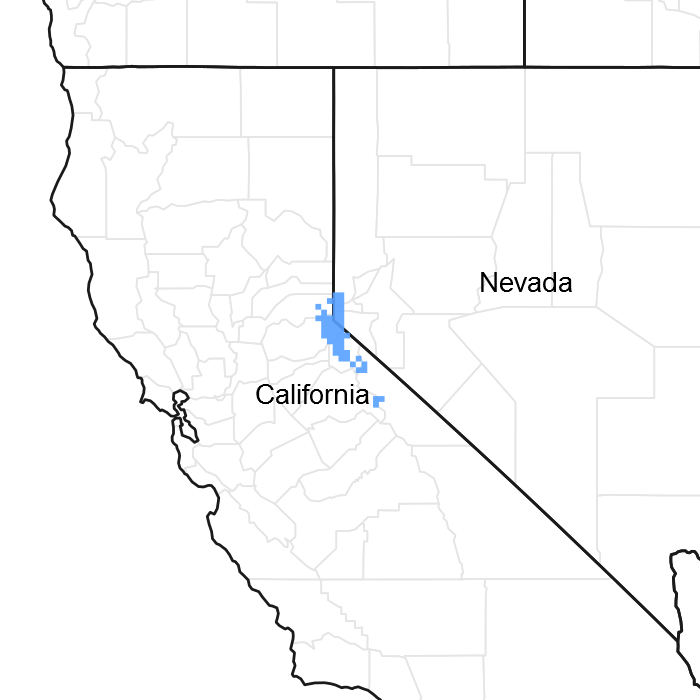

Natural Resources
Conservation Service
Ecological site F022AF004CA
Frigid, Shallow To Deep, Sandy Mountain Slopes
Accessed: 12/22/2025
General information
Approved. An approved ecological site description has undergone quality control and quality assurance review. It contains a working state and transition model, enough information to identify the ecological site, and full documentation for all ecosystem states contained in the state and transition model.

Figure 1. Mapped extent
Areas shown in blue indicate the maximum mapped extent of this ecological site. Other ecological sites likely occur within the highlighted areas. It is also possible for this ecological site to occur outside of highlighted areas if detailed soil survey has not been completed or recently updated.
MLRA notes
Major Land Resource Area (MLRA): 022A–Sierra Nevada and Tehachapi Mountains
MLRA22A
Major Land Resource Area 22A, Sierra Nevada Mountains, is located predominantly in California and a small section of western Nevada. The area lies completely within the Sierra Nevada Section of the Cascade-Sierra Mountains Province. The Sierra Nevada range has a gentle western slope, and a very abrupt eastern slope. The Sierra Nevada consists of hilly to steep mountains and occasional flatter mountain valleys. Elevation ranges between 1,500 and 9,000 ft throughout most of the range, but peaks often exceed 12,000 ft. The highest point in the continental US occurs in this MLRA (Mount Whitney, 14,494 ft). Most of the Sierra Nevada is dominated by granitic rock of the Mesozoic age, known as the Sierra Nevada Batholith. The northern half is flanked on the west by a metamorphic belt, which consists of highly metamorphosed sedimentary and volcanic rocks. Additionally, glacial activity of the Pleistocene has played a major role in shaping Sierra Nevada features, including cirques, arêtes, and glacial deposits and moraines. Average annual precipitation ranges from 20 to 80 inches in most of the area, with increases along elevational and south-north gradients. Soil temperature regime ranges from mesic, frigid, and cryic.
LRU "F" Northeast Mixed Conifer: This LRU includes the drier eastside forests of the northern Sierra Nevada that occur north of Bridgeport, the eastern, lower elevations of the Tahoe area, and the northern extent of the Sierra near Susanville, most closely corresponding to EPA ecoregion 5f. Elevations are typically between 5,000 and 8,000 feet. The frost free season is between 50 and 100 days, MAAT is between 40 and 48 degrees F, and MAP is typically between 17 and 35 inches, but may range higher in the northernmost section. This LRU exists in the rain shadow formed by the Sierra Nevada Crest, and consequently has much lower precipitation than equivalent elevations on western slopes. Soil temperature regimes are mostly frigid, with some cryic. Soil moisture regimes are xeric.
Classification relationships
Forest Alliance = Pinus jeffreyi – Jeffrey pine forest; Association = tentatively Pinus jeffreyi/Purshia tridentata var. tridentata. (Sawyer, John O., Keeler-Wolf, Todd, and Evens, Julie M. 2009. A Manual of California Vegetation. 2nd ed. California Native Plant Society Press. Sacramento, California.)
Ecological site concept
This ecological site is found on south-facing mountain slopes, primarily on the eastern side of Lake Tahoe in the Carson Range, which receives the lowest precipitation in the Lake Tahoe Basin. Elevations are typically between 6,200 and 7,600 feet and slopes are typically between 15 and 50 percent. Soils are moderately deep to deep, or shallow over paralithic granitic bedrock (Cr), and sandy with low available water capacity and nutrients. This exposed, low-water environment supports an open canopy Jeffrey pine (Pinus jeffreyi) forest with a patchy shrub understory. Greenleaf manzanita (Arctostaphylos patula) and antelope bitterbrush (Purshia tridentata) are the most common shrub species. These coarse soils and exposed sites do not support an extensive herbaceous understory, and forbs and grasses are sparse on this site.
Associated sites
| F022AC003CA |
Frigid-Cryic Sandy Slopes Occurs on adjacent higher elevation slopes. It is dominated by red fir (Abies magnifica) and western white pine (Pinus monticola), with pinemat manzanita (Arctostaphylos nevadensis) in the understory. |
|---|---|
| F022AF005CA |
Frigid, Deep To Very Deep, Sandy-Loamy Mountain Slopes Occurs on adjacent north-facing slopes with very deep soils. Jeffrey pine (Pinus jeffreyi) and white fir (Abies concolor) co-dominate. |
| F022AX100CA |
Frigid, Sandy, Moist, Outwash Fan Occurs on adjacent outwash fans with very deep poorly drained soils. Sierra lodgepole pine forest (Pinus contorta var. murrayana) is dominant. |
Similar sites
| F022AF002CA |
Frigid, Sandy, Or Loamy Outwash Occurs on gently sloping outwash, moraines and outwash fans with moderatley deep to very deep soils of mixed origin. Productivity is higher. |
|---|---|
| F022AC004CA |
Cryic Very Gravelly Loamy Mountain Slopes This site occurs at higher elevations with a cryic soil temperature regime. Soils are very deep with loamy textures. Red fir (Abies magnifica) and Jeffrey pine (Pinus jeffreyi) dominate the canopy with a dense shrub layer of roundleaf snowberry (Symphoricarpos rotundifolia) and wax currant (Ribes cereum). |
| F022AF006CA |
Loamy Frigid Metamorphic Slopes Occurs on very deep, fine loamy soils developed from metamorphic parent material. The forest is dominated by a denser, more productive Jeffrey pine (Pinus jeffreyi) and white fir (Abies magnifica) forest, and a diverse herbaceous understory is present. |
| F022AF005CA |
Frigid, Deep To Very Deep, Sandy-Loamy Mountain Slopes Occurs on north-facing slopes with very deep soils. Species composition is similar, but there is a higher cover and basal area of Jeffrey pine (Pinus jeffreyi), and white fir (Abies magnifica) is more important on this site. |
| F022AE007CA |
Frigid, Sandy, Moraines And Hill Slopes Occurs in higher precipitation zones on moderately deep to very deep soils derived from glacial outwash and till from mixed parent materials. This site supports a much denser Jeffrey pine (Pinus jeffreyi) and white fir (Abies magnifica) forest. |
Table 1. Dominant plant species
| Tree |
(1) Pinus jeffreyi |
|---|---|
| Shrub |
(1) Purshia tridentata |
| Herbaceous |
Not specified |
Click on box and path labels to scroll to the respective text.

